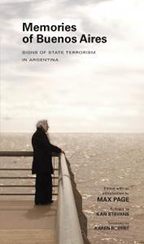AMHERST, Mass. – Throughout Central and South America, there remains the palpable awareness of the decades-long “Dirty War,” in which the military and oligarchy joined forces in brutal and relentless repression of democratic institutions, and many tens of thousands people were simply marked for disappearance. That war has retained its own emotional and physical topography in the region, especially in Argentina, where as many as 30,000 citizens were killed after the generals seized power in 1976.
Now, Max Page, professor of architecture and history at the University of Massachusetts Amherst, has edited a new book that explores that topography and serves as an interpretive guide to the terror in Argentina, invoking the memory of the disappeared, the desaparecidos, in the memorials and hidden places of torture that mark the capital.
Memories of Buenos Aires: Signs of State Terrorism in Argentina, which includes an introduction by Page, identifies the city’s hundreds of grassroots memorials to the victims – as well as the sites of their torment – in an effort to document the origins, the evolution and the scope of the dirty war. “This book remaps Buenos Aires for scholars and visitors alike,” said Page. “It shows how the dictatorship’s tentacles reached into every corner of the city. It is a necessary part of the process of coming to terms with that time.”
The book was originally published in Spanish by the human rights organization Memoria Abierta, which fashioned a historical framework from interviews with survivors. It has been translated by Karen Robert of St. Thomas University, with an epilogue by Ilan Stavans of Amherst College.
Published by the University of Massachusetts Press, which calls it a “comprehensive guidebook to clandestine sites of horror as well as innovative sites of memory,” the book divides the 48 districts of the city into nine sectors, and then proceeds neighborhood-by-neighborhood to offer descriptions of 202 known “sites of state terrorism” and 38 additional places where people were illegally detained, tortured and killed by the government.
That inventory, unfortunately, will likely remain a work in progress, says Page.
As recently as Oct. 30, a vast new trove of more than 1,500 secret files documenting the Dirty War was discovered in Argentine air force offices, according to The New York Times. The files were said to contain blacklists of artists and intellectuals.
“At one point, the list totaled 19 pages of names of artists and intellectuals deemed to have subversive leanings, including the novelist Julio Cortázar and the folk singer Mercedes Sosa. The list was drawn up by the dictatorship in an attempt to block support for such figures from state bureaucrats and private news organizations,” according to the Times.
*Source: University of Massachusetts Amherst

